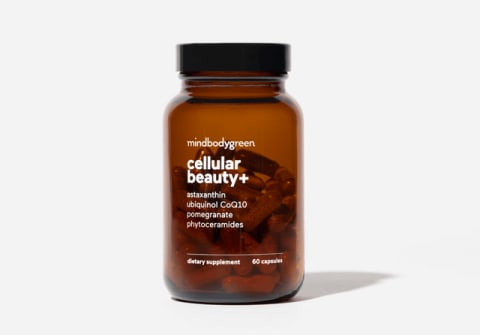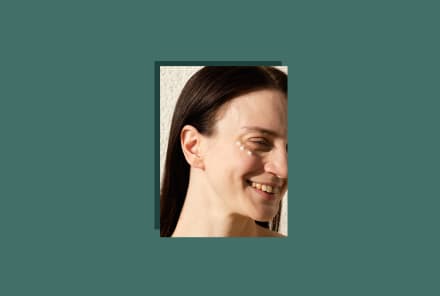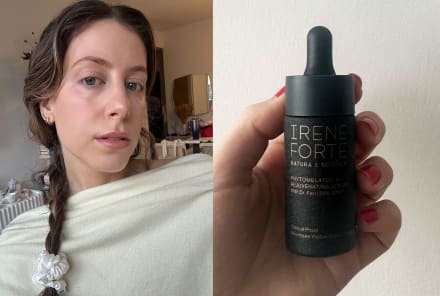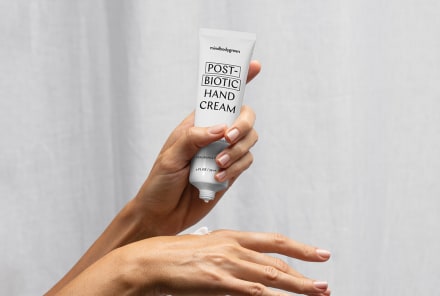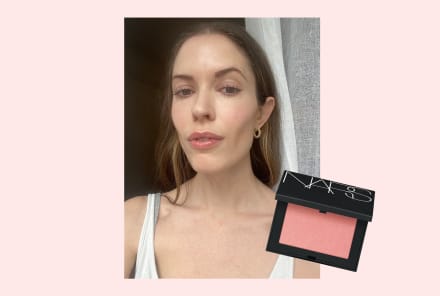Advertisement
You're Probably Taking The Wrong Form Of This Antioxidant — But Here's A Swap

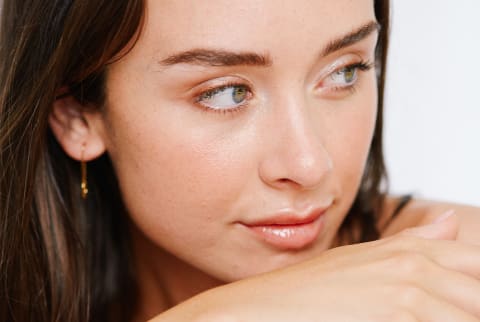
Everything is skin care—your plate included. Yes, there's a reason derms and skin care experts always recommend "eating the rainbow" of fruits and vegetables, getting adequate healthy fats, and staying hydrated: Because what you consume affects your health and overall appearance. But since you're here at mindbodygreen, I'm going to wager you're already a believer that what you eat affects your skin—and won't try to convince you further.
One of the most beloved dermatologist recommendations is salmon. In fact, it's probably one of the most common pieces of lifestyle advice I get from skin care experts: Enjoy salmon, and, for bonus points, eat the skin.
Now, there are several reasons salmon is good for the skin: It's high in omega-3s, is a good source of lean protein, contains essential vitamins and minerals (like B vitamins, potassium, and selenium), and is loaded with antioxidants.
Let's dive in a little closer to that last one. Not only does salmon contain antioxidants, but its star is also a pretty unique one called astaxanthin. If you familiarize yourself with beauty and wellness lingo, you may know this special carotenoid. If not, allow me to explain—and why you may need to get it from additional sources other than salmon.
What is astaxanthin & why is it beneficial for skin?
Astaxanthin is a member of the carotenoid family and a potent antioxidant that comes from microalgae. It's a free-radical-fighting powerhouse that is clinically shown to improve skin hydration, increase elasticity, improve skin texture, and reduce fine lines and age spots.*
Just take a peek at this comprehensive review on astaxanthin for skin health1: The data summary looks at numerous astaxanthin clinical research studies for skin health outcomes—and found benefits in spades.*
For example, in one randomized controlled trial with 46 healthy female participants—researchers found that those who took astaxanthin capsules for six weeks had significantly decreased wrinkle parameters compared to participants who took a placebo pill.* Another randomized controlled trial studied 65 healthy females and found that participants who took astaxanthin supplements had reduced wrinkles2 after 16 weeks, compared to the control group.* Finally, when 30 healthy females took astaxanthin capsules and applied a topical astaxanthin solution for eight weeks, their age spots decreased in size3; not to mention, they experienced an increase in skin elasticity and enhanced skin texture, too.*
Why you should supplement astaxanthin as well.
Listen, salmon is still a solid dietary choice, as it has many other benefits and nutrients. But in terms of astaxanthin, it may not be cutting it. According to a report by the European Food Safety Authority, the amount of astaxanthin in salmon varies pretty dramatically. From their findings, farm-raised salmon and fish of all varieties had lower levels of the antioxidant than wild-caught. Additionally, the type of fish matters, too—with sockeye salmon containing the most and arctic char, rainbow trout, and Atlantic salmon toward the bottom.
But let's take king salmon for an example, which falls about in the middle with 0.54 milligrams of astaxanthin per 100-gram fillet of salmon flesh. If you wanted to consume 6 milligrams of astaxanthin (read: the dosage in mbg's cellular beauty+, and the amount that can help support healthy skin function according to the latest clinical research1*), you'd have to consume about 11 100-gram (3.5-oz.) salmon fillets daily. Not only is that, well, a lot of potentially pricey fish, but it also exceeds the recommended daily amount, according to the FDA4.
Additionally, you may be wondering—can't I simply get the antioxidant elsewhere? Well, to answer that, we have to dive back into where the antioxidant comes from. It's naturally found in algae that the salmon and other marine life (such as shrimp, crabs, and lobster) feed on. In fact, it's what gives those animals their pinky-peach hue! But that's also why wild-caught, non-farm-raised seafood is the only good food source of this superstar antioxidant.
But brands, such as AstaReal® (mbg's astaxanthin source), can sustainably harvest this unique phytonutrient directly from the algae themselves (in this case, a freshwater green algae called Haematococcus pluvialis, aka H. pluvialis). Not so little bonus: This means the sourcing is a more planet-friendly and vegan alternative to seafood.
The takeaway.
If you want glowing skin, you need to consider what you're consuming. While salmon is a great food for many skin-supporting reasons (and mbg prefers the wild-caught variety whenever possible), you likely need to consider adding an astaxanthin supplement, like mbg's cellular beauty+, to your routine if you want to optimize the phytonutrient benefits.*
Watch Next
Enjoy some of our favorite clips from classes
Enjoy some of our favorite clips from classes
What Is Meditation?
Mindfulness/Spirituality | Light Watkins
Box Breathing
Mindfulness/Spirituality | Gwen Dittmar
What Breathwork Can Address
Mindfulness/Spirituality | Gwen Dittmar
The 8 Limbs of Yoga - What is Asana?
Yoga | Caley Alyssa
Two Standing Postures to Open Up Tight Hips
Yoga | Caley Alyssa
How Plants Can Optimize Athletic Performance
Nutrition | Rich Roll
What to Eat Before a Workout
Nutrition | Rich Roll
How Ayurveda Helps Us Navigate Modern Life
Nutrition | Sahara Rose
Messages About Love & Relationships
Love & Relationships | Esther Perel
Love Languages
Love & Relationships | Esther Perel
